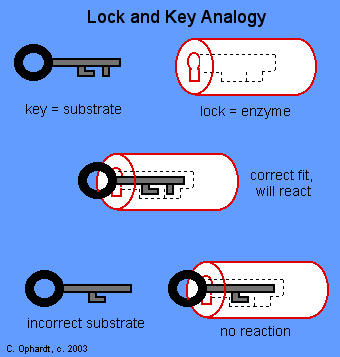Why is the structure of an enzyme referred to as a "lock and key"?
1 Answer
The structure of enzymes is usually called Lock and Key, to depict their binding specificity to its target.
Explanation:
Enzymes are proteins which catalyse a single or various biological processes in a cell. Cells have a diverse array of molecules present in them and are required to perform different processes. These molecules are free to interact with any protein present in a cell, with these non-specific interactions cell biological machinery will slow down significantly.
To overcome these non-specific interactions enzymes have adopted the strategy of Lock and Key. Enzymes only allow binding of molecules that can fit in their active site. As, these active sites (can be called locks) are very specific and only few molecules (can be called keys) can bind them, this model of enzyme working is called Lock and Key mechanism.
Image below shows how only a specific key can use enzymes ability to catalyze a product formation.

another version of similar question is here

